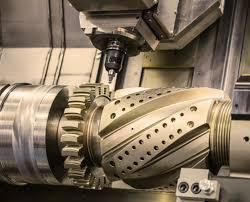When it comes to manufacturing plastic parts, businesses and product designers are often faced with a critical decision: CNC machining or injection molding?
Both methods are widely used in modern manufacturing and offer unique advantages. The key lies in understanding how each process works, their costs, material compatibility, scalability, and ideal use cases—especially when producing small batches.
In this guide, we’ll compare CNC machining and injection molding, with a special focus on low volume plastic injection molding, to help you choose the right process for your next project.
🔧 What Is CNC Machining?
CNC (Computer Numerical Control) machining is a subtractive process where material is removed from a solid block (typically metal or plastic) using precisely controlled cutting tools. The process is computer-guided and capable of producing complex parts with tight tolerances.
Pros:
-
High precision and tight tolerances
-
Great for prototyping or small-volume runs
-
No upfront tooling cost
-
Suitable for a wide range of materials
Cons:
-
Slower for high-volume production
-
More expensive per unit at scale
-
Greater material waste
Best for: Prototypes, highly complex geometries, or low-quantity parts requiring high precision.
🧩 What Is Injection Molding?
Injection molding is a manufacturing method that involves injecting molten plastic into a custom mold cavity. Once cooled, the mold opens, and the part is ejected. It’s ideal for producing thousands—or even millions—of identical plastic parts.
However, traditional injection molding has high upfront tooling costs, making it cost-effective only for large production runs. That’s where low volume plastic injection molding comes in.
This method uses simplified tooling and fast-turnaround molds to make short-run plastic parts more affordable—perfect for startups, product validation, or bridge production before mass manufacturing.
Pros:
-
Low cost per unit at medium to high volumes
-
Consistent part quality and surface finish
-
Rapid production once tooling is complete
-
Suitable for complex part geometries
Cons:
-
High initial tooling costs (even in low-volume molding)
-
Longer lead times upfront due to mold design
-
Less flexible for design changes once mold is made
Best for: Medium-volume production, product launches, and functional prototypes using end-use plastic materials.
⚖️ CNC Machining vs. Injection Molding: A Feature Comparison
| Feature | CNC Machining | Injection Molding |
|---|---|---|
| Process Type | Subtractive | Additive/forming |
| Setup Time | Low | Moderate to High |
| Tooling Cost | None | High (less in low-volume molding) |
| Unit Cost (Low Volumes) | High | Low (after tooling is complete) |
| Lead Time | Fast | Slower (initial mold creation required) |
| Material Waste | High | Minimal |
| Surface Finish | Good | Excellent |
| Tolerances | Very tight | Moderate (improved with precision tooling) |
| Design Flexibility | High | Low (once mold is finalized) |
💡 When to Choose CNC Machining
CNC machining is ideal when:
-
You’re developing a prototype or testing multiple design iterations
-
You need a few parts made quickly
-
Your part requires high mechanical strength or tight tolerances
-
You’re using specialty plastics or composite materials
-
Modifications or customization is expected
It’s also the better choice for non-plastic parts like metals, ceramics, or hybrid assemblies.
🚀 When to Choose Low Volume Plastic Injection Molding
Low volume plastic injection molding is best when:
-
You need between 100 and 10,000 units
-
The part is finalized and doesn’t require ongoing design changes
-
You need a professional-grade finish
-
Consistency across parts is critical
-
You want to bridge the gap between prototype and mass production
Low volume molding provides a balance between quality and affordability, helping businesses scale their manufacturing without the risks of full production tooling.
🛠️ Real-World Use Case Scenarios
1. Medical Device Prototyping
Use CNC machining to create functional prototypes from high-performance plastics like PEEK or Delrin. Later, transition to low volume injection molding for field testing or regulatory trials.
2. Consumer Product Launch
Startup brands often begin with CNC-machined prototypes to test fit and function. Once the design is validated, they switch to low volume plastic injection molding for initial product runs, keeping unit costs lower without investing in full production tooling.
3. Automotive Components
Custom parts like dashboards or housing enclosures can be CNC machined during early-stage R&D. After performance validation, injection molding helps scale to pre-production quantities before full deployment.
💬 Expert Insight: Hybrid Approach
Many manufacturers today adopt a hybrid approach, using CNC machining for:
-
Iterative testing
-
Engineering approval
-
Market testing
And low volume injection molding for:
-
Beta units
-
Product sampling
-
Pilot production
This strategy balances time-to-market, cost-efficiency, and flexibility.
📈 Cost Comparison: A Quick Snapshot
| Production Volume | CNC Machining (Estimate) | Low Volume Injection Molding (Estimate) |
|---|---|---|
| 1–10 units | ✅ Cost-effective | ❌ High due to tooling |
| 100–500 units | ❌ Higher per-unit cost | ✅ Competitive pricing |
| 1,000+ units | ❌ Not economical | ✅ Best value |
Remember: Even though CNC machining may seem more flexible, its cost curve rises sharply with higher quantities.
🔍 Conclusion: The Right Process for the Right Stage
There is no one-size-fits-all answer when it comes to choosing between CNC machining and injection molding. The decision depends on:
-
Your design stage
-
Quantity needed
-
Budget and timeline
-
Material requirements
-
End-use environment
If you're ready to scale but not quite at full-volume production, low volume plastic injection molding is an ideal choice. It offers the speed, quality, and affordability growing businesses need.
📞 Need Help Deciding Which Manufacturing Method is Right?
Let the experts at CNC Machining Services guide your next project. Whether you're looking to prototype a part, produce a small batch, or transition to scaled production, their team is equipped to support your manufacturing journey from concept to completion.
